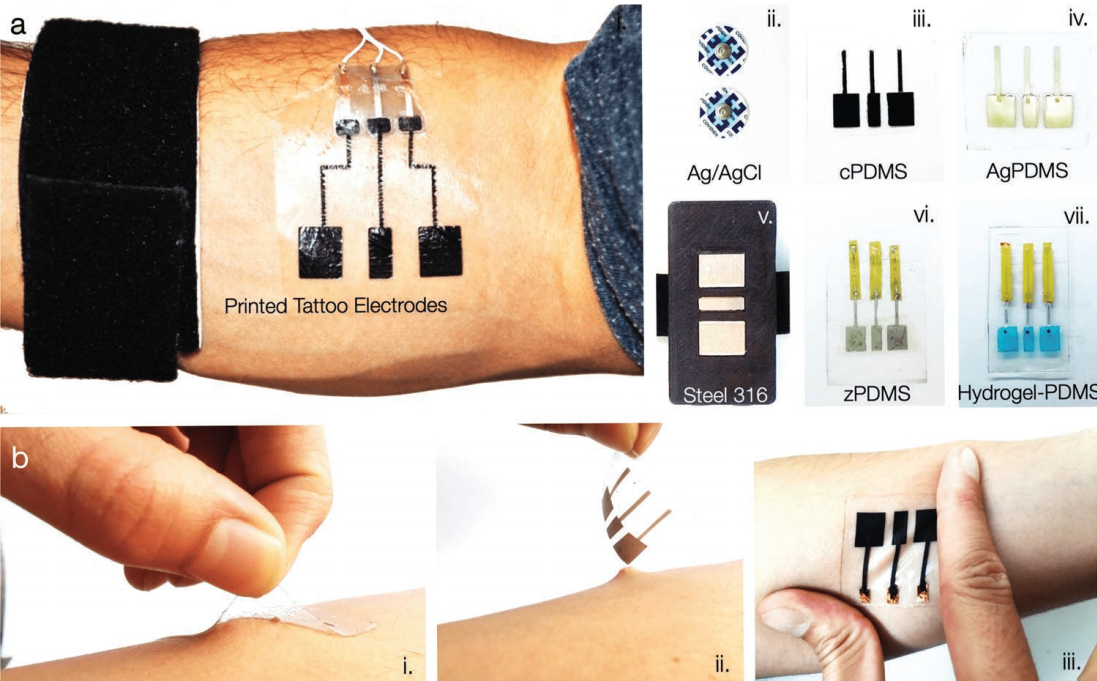Soft Bioelectronic Stickers:
Pedro Alhais Lopes
Davide Vaz Gomes
Daniel Green Marques
Pedro Faia
Joana Góis
Tatiana F Patrício
Jorge Coelho
Arménio Serra
Aníbal T de Almeida
Carmel Majidi
Mahmoud Tavakoli
Surface biopotentials collected from the human epidermis contain important imformation about human physiology, such as muscular, heart, and brain activities. However, commercially available wearable biomonitoring devices are generally composed of rigid hardware incompatible with the mechanical compliance of soft uman tissues. Thin-film stretchable e-skin circuits that can interface the human skin represent an excellent,alternative for long-term wearable biomonitoring. Here, a series of soft and stretchable electrodes are evaluated for their applicability in biopotential sensing. This includes conductive composites made of olydimethylsiloxane (PDMS) as a base substrate and conductive particles, i.e., carbon (cPDMS), silver (AgPDMS), anisotropic z-axis conductors made with silver-coated nickel particles (zPDMS), as well as a combination of a conductive tough hydrogel with PDMS, and finally ultrathin tattoo-like adhesive poly(vinyl alcohol)-coated films with stretchable biphasic Ag-EGaIn electrodes. These electrodes are compared between themselves and against the gold-standard Ag/AgCl and stainless steel electrodes, in order to assess relative performance in signal-to-noise ratio (SNR) during electrocardiography, and electrode-skin impedance for a range of frequencies. Results show a direct relation between conformity of the electrode–skin interface and the SNR value. An all-integrated biomonitoring patch with embedded processing and communication electronics, hydrogel electrodes, and a multilayer liquid metal circuit is presented for electromyography.
The seven types of electrodes are compared in this work. a) From left to right: i) Tattoo-like electrodes applied and conformed to the ubject’s arm for biopotential acquisition; ii) gold-standards commercially available gel Ag/AgCl and v) dry stainless-steel electrodes; iii) cPDMS, iv) AgPDMS, vi) zPDMS, and vii) hydrogel-PDMS assembly. Hydrogel electrodes are colored with a blue pigment to be distinguishable from PDMS backing. b) i,ii) Peeling and deformation of applied electrodes on the forearm’s skin. iii) The developed soft electrodes show adhesion and conformity to the skin.


a) Exploded schematics of the EMG device with hydrogel-PDMS electrodes, composed of on-skin electrodes, integrated circuits Bluetooth, operational amplifier), other surface-mount devices (resistors, capacitors) and three EGaIn circuit layers, all interconnected by EGaIn VIAs. b) The patch (110 mm × 60 mm) attached to the forearm with the electronics facing upward and the electrodes over the internal muscle of the forearm. c) Backview of the patch. Major components are labeled. d) i) Bending, ii) twisting, and iii) adhesion are shown. e) The electromyography patch is adhered over the forearm placing the electrodes on i) the flexor carpi ulnaris muscle zone to acquire surface biopotentials for ii) closing and iii) flexing gestures.
Soft Bioelectronic Stickers: Selection and Evaluation of Skin‐Interfacing Electrodes.
, , , , , , , , , , , Soft Bioelectronic Stickers: Selection and Evaluation of Skin‐Interfacing Electrodes. Adv. Healthcare Mater. 2019, 8, 1900234.

